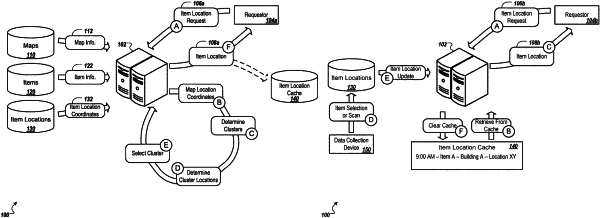| CPC G01C 21/3841 (2020.08) [G01C 21/367 (2013.01); G01C 21/3644 (2013.01); G01C 21/3679 (2013.01); G01C 21/383 (2020.08); G01C 21/3896 (2020.08); G06Q 30/0643 (2013.01)] | 24 Claims |

|
1. A computer-implemented method comprising:
receiving, from a requestor device, an item location request for an item;
receiving map information for a mapped space of a retail environment in which the item is located;
receiving item location coordinates corresponding to locations within the mapped space at which the item has been previously selected or scanned using various different data collection devices over time;
mapping, by one or more processors, the item location coordinates with respect to the mapped space;
determining, by one or more processors, a plurality of clusters for the item location coordinates, based on the mapping, wherein determining the plurality of clusters includes using a machine learning algorithm to group data points representing the item location coordinates with respect to the mapped space into the plurality of clusters, wherein the machine learning algorithm groups the data points into at least three clusters;
determining, by one or more processors and for each cluster of the plurality of clusters, a representative location of the cluster, based on the data points of the cluster;
determining, by one or more processors, a selected cluster, by eliminating two or more of the clusters from the plurality of clusters and selecting from one or more remaining clusters, wherein eliminating two or more of the clusters includes:
(i) comparing a number of data points in each cluster of the plurality of clusters, and eliminating, from the plurality of clusters, at least one cluster that includes fewer data points relative to other clusters, and
(ii) eliminating, from the plurality of clusters, at least one cluster that has a representative location that is within a predefined area of the mapped space of the retail environment that is designated as a check-out register area and that is designated as excluding an assigned location of the item according to item planogram information for the item, wherein the item planogram information indicates one or more assigned locations for the item within the mapped space; and
providing, to the requestor device, an estimated location of the item, based at least in part on the representative location of the selected cluster.
|